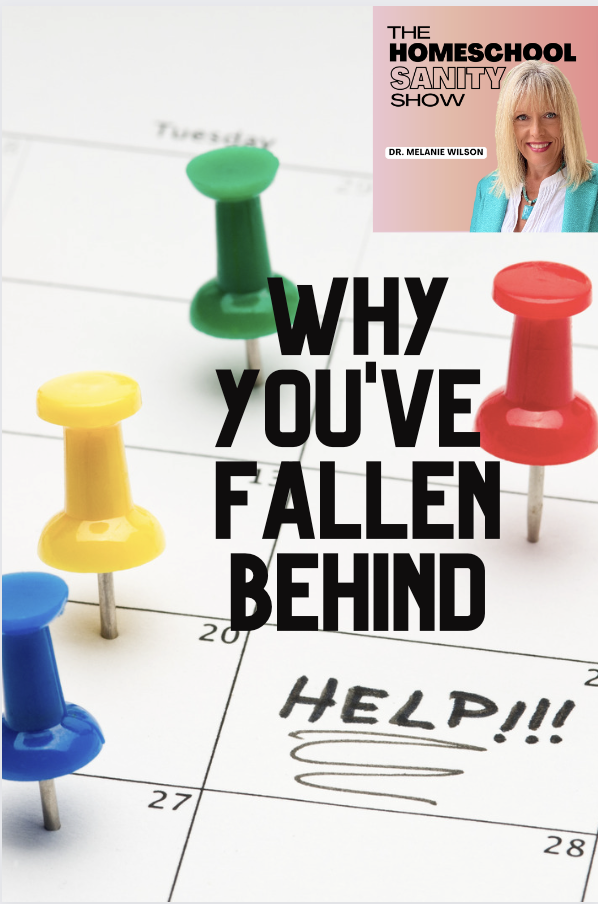Have you fallen behind in your homeschool plan? Do you want to avoid looking at your lesson planner because it’s so depressing? If that’s you, I have good news. This is The Homeschool Sanity Show, the episode where we'll get back on track.
Sponsor: 5000 Blankets Movie
It's incredible what can happen when you transform your heart to serve the people around you.Catch 5000 BLANKETS exclusively in theaters for two days only! December 12 & 13. Tickets at https://www.fathomevents.com/events/5000-Blankets
The Planning Fallacy
Now the good news: There’s nothing wrong with you! You’ve just fallen victim to a human thinking error that’s characteristic of some of the smartest people. It’s called the planning fallacy. It means we tend to underestimate how much time projects take, even when we have experience that has taught us better.
So you tell yourself you can get the science experiment part of your curriculum done in half an hour, even though they’ve taken you at least three times as long in the past. Why are we irrational this way? Because we also have an optimism bias—especially when it comes to our own abilities.
I’ve been watching a baking show, a baking competition in which bakers make elaborate baked goods in a very short amount of time. Even though a baker will admit to never having made the recipe at home under the time limit, she hopes that she will for the competition. She hopes. It’s a kind of magical thinking that we’re all guilty of at times. You’ve never made it to co-op in under ten minutes, but you hope you will today—somehow.
Why do we have this optimism bias and this magical thinking about the future? Researchers have a number of theories:
First, we use the best-case scenario in our planning. For example, we tell ourselves we can get to church in six minutes because of that one time when every light was green.
Second, we plan this way because we want to believe that our scenario will happen. We avoid the disappointment of admitting that there is no possible way we can complete two foreign language curricula in one year.
Third, we honestly don't remember how long a similar project took. We think the math lesson took ten minutes to complete when it actually took 20.
Fourth, we emphasize the differences between the current project and a past one. Yes, science experiments took forever last year, but now you're organized. And your kids are more mature.
Fifth, long-term deadlines promote poorer time estimates. We do worse in realistically planning for a full school year than we do for this week.
Sixth, we focus on the variables that we can control, forgetting that much of the most time-consuming parts of our day are unexpected and out of our control. We don't know that our printer will stop working right when we go to print the lab worksheets or that the dog will get out of the yard as we're about to start the art lesson.
How to Overcome the Planning Fallacy
I don't know about you, but I'm getting depressed. Maybe we should scrap our homeschool plan and just see what happens? Depending on your homeschool laws, you might not have that choice. Or you know that you get far less done without a plan. So you'd still like to plan in such a way that you don't fall far behind. How can we do that?
First, instead of using a best-case scenario, let's use a worst-case one. In a study of college students who used this strategy, researchers found that the students did even worse than their worst-case scenario. But at least they were closer! If this is challenging for you to do, try doubling your time estimates. If you're anything like me, you'll push back against this. “There's no way it's going to take four hours to get a science experiment done!” Then split the difference. Plan on three hours and if you have time left over, you can catch up on other subjects or have some down time.
Second, we can admit to ourselves that we can't do everything we want to do this year. But the good news is we'll have something exciting to look forward to next year! It might help you feel less disappointed to make a list of the great activities and curricula you'll take on another time.
Third, start timing your activities. Don't rush through the science experiment. See how long it really takes you on average.
Fourth, consider the similarities between your current plan and what you did last year. If you still have a tendency to start school later…if your kids still dawdle over the lesson…if you don't like dragging out the supplies any more this year than last, think again about what you can realistically accomplish.
Fifth, consider planning for the short-term if you're a yearly planner. Plan for the quarter, the month, the week, or even the day if you feel more in control of your time. One way to increase your motivation for completing the plan is to use the free quarterly planner I've created. When you and your kids finish their work for the quarter, they get the rest of the time off. This worked like a charm for my kids!
Finally, think about the obstacles that got in the way of your homeschooling last week. Was someone sick? Did the washing machine leak? Was a family member or friend in need of help? One of the best ways we can accommodate the unexpected is to have margin in our plan. Just as the margins of a page have nothing on them, our plan or schedule should have spaces where nothing is there. We can keep an hour of our day, a day a week, or even a week a month unplanned to manage those times when we get behind. The key to making this work is not to treat the unplanned time like a tax refund. What I mean is, we shouldn't put our schoolwork off, thinking that we'll just use our unplanned time to do it. Even though the time is unplanned, we should treat it as reserved for emergencies only. If nothing comes up, we have time to relax or have some spontaneous fun!
Thanks again to 5000 Blankets for their sponsorship.
Have a happy homeschool week!

